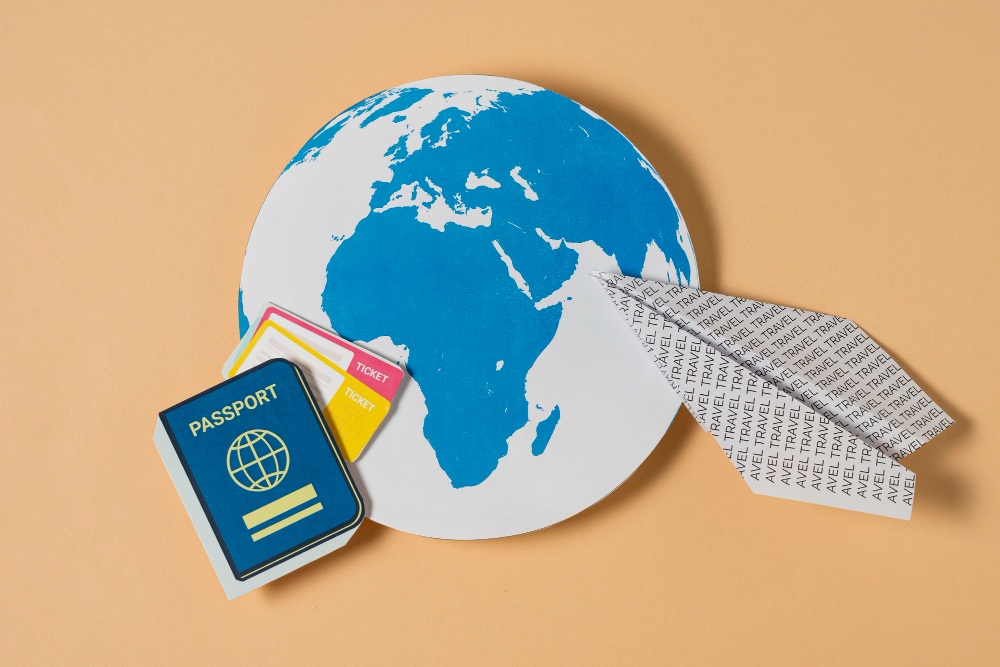Imagine a world where visas no longer exist.
The United Nations announces that all human movement is now legal, free, and unrestricted. Overnight, the visa system vanishes: no need to queue outside embassies, pay high fees, or wait months for approval. You simply carry your passport, buy a ticket, and move.
How would it affect the world?
This sounds radical, but it’s worth exploring because the forces pushing in that direction are building. Demographic decline, climate displacement, and labor shortages are already testing the visa system.
Thinking through this scenario helps us see what’s at stake and what needs attention now.
Immediate changes
The first change is that migration becomes cheaper and safer. Smuggling networks would collapse because people no longer need to risk dangerous crossings. The International Organization for Migration estimates that over 77,000 migrants have died since 2014 trying to cross borders illegally.
In an open system, that death toll would plummet as regular transport replaces irregular channels. Airlines, bus operators, and ferry companies would benefit from new demand, while border enforcement agencies would need to redirect resources from interdiction to processing and monitoring.
Customs controls would still matter for goods, and health checks for travelers would remain. But the power of states to say “you don’t qualify” would disappear. The distinction between legal and illegal entry would collapse, replaced by a universal right of movement.
That would require new identity management systems to verify who people are, track residence, and integrate them into taxation and services. Technology firms specializing in biometrics, secure digital IDs, and cross-border data exchange would find huge new markets in this environment.
Asylum systems would lose much of their relevance. People fleeing war or persecution wouldn’t need to claim protection at the border; they’d simply move. The debate would shift to rights and services after arrival.
Governments would have to decide how quickly newcomers could access housing, healthcare, and welfare benefits, and what responsibilities—such as taxation or community registration—would apply.
The initial phase of open borders would test the speed and fairness of these adjustments, shaping whether societies see new arrivals as contributors or burdens.
Who would move
In the first year, we’d see large-scale family reunions. People long separated by paperwork—parents, children, siblings—would buy tickets and reconnect. Students would fly to schools abroad without waiting for permits.
Employers in sectors with chronic shortages, such as agriculture, construction, and care work, would fill vacancies quickly. Tourism would also see an immediate boom as people who were previously restricted by visa regimes take advantage of new freedom to travel.
Over time, larger patterns would take shape. South and Southeast Asia, Sub-Saharan Africa, and Latin America would supply significant numbers of workers to North America and Europe, filling roles in industries that struggle with domestic labor supply.
Retirees from Europe and North America would move to warmer, lower-cost countries like Mexico, Thailand, or Morocco, creating new demand for healthcare and housing in those regions.
Entrepreneurs and researchers would cluster in innovation hubs such as Silicon Valley, Berlin, or Singapore. Meanwhile, smaller cities with strong planning and infrastructure could emerge as surprise destinations if they manage to scale housing and services effectively.
We’d also see circular and seasonal migration grow. Workers might spend summers in Northern Europe harvesting crops, then return to home countries for part of the year. Students might build global careers by moving between campuses and research labs.
Families could split residence across multiple countries, creating new forms of transnational living. Cities that manage housing and infrastructure well would attract the most newcomers, but even less traditional destinations could gain if they offer affordability, safety, and opportunity.
Economic impacts
The economic implications are vast and deeply researched. Studies by economists Michael Clemens and Lant Pritchett estimate that removing migration barriers could more than double global GDP, with gains ranging from 50-150%.
The reason is straightforward: workers are far more productive when they move from low-output to high-output economies. A Nigerian construction worker in Lagos might earn $200 per month. In Houston, the same worker could earn ten times that amount, building infrastructure that supports far greater economic activity.
These productivity gaps are at the heart of migration economics. They show why remittances are such a powerful force today. The World Bank reported that remittances to low- and middle-income countries reached $669 billion in 2023, far outpacing foreign aid and often exceeding foreign direct investment.
If visas disappeared, those flows would expand dramatically. Families in origin countries would gain more stable incomes, and communities would see rising investment in housing, health, and education.
Beyond remittances, open borders would stimulate global trade and consumption. Migrants increase demand for goods and services, which in turn spurs business growth. Labor shortages in agriculture, logistics, and healthcare would ease, allowing industries to expand production.
Innovation would accelerate as diverse teams fuel new ideas, as seen in U.S. patent data linking immigrant workers to higher invention rates. At the same time, capital would shift geographically to follow labor supply, spreading economic growth more evenly across the globe.
The impacts wouldn’t be uniformly positive or immediate. In the short run, wages in certain low-skill sectors might dip as supply expands. But over time, the combination of stronger consumer demand, higher productivity, and more efficient labor matching would outweigh these disruptions.
The key challenge would be managing transition costs so that short-term dislocations don’t overshadow the long-term prosperity gains.
The pressure points
Yet growth wouldn’t be evenly distributed. Three areas would determine whether open borders succeed or fail: housing, transport, and infrastructure.
Housing is the most immediate bottleneck. In London, rents already consume roughly 41% of the average household’s income. In New York, supply constraints drive prices to levels many locals can’t afford. If inflows double or triple without housing reform, resentment will grow.
Preliminary research from economists like Enrico Moretti shows that restrictive zoning laws in U.S. cities have already cost trillions in lost productivity by preventing workers from moving where jobs are most productive. Without change, those same restrictions would turn open borders from opportunity into crisis.
Transport is the second choke point. Congested metros like Lagos or Manila already struggle to move their populations. Adding millions of new residents would paralyze daily life unless governments expand transit networks.
Case studies show that transport systems must scale with population growth for cities to remain livable and productive. Seoul’s subway expansion and Bogotá’s bus rapid transit are examples of infrastructure keeping pace with demand.
The third factor is infrastructure and services. Schools, hospitals, water, and electricity grids need to absorb shocks. South Africa’s rolling blackouts demonstrate what happens when infrastructure doesn’t keep pace with demand.
By contrast, Singapore’s careful planning shows how a city-state with few natural resources can handle large migrant inflows while maintaining high living standards.
Winners and the squeezed
Open borders create clear winners. Employers gain access to workers, solving shortages in care, agriculture, and logistics. Consumers benefit from lower prices for services.
High-skill workers thrive in larger, more dynamic teams where diversity drives innovation. Aging societies gain the young workers they desperately need to fund pensions, support healthcare systems, and provide hands-on care for older citizens.
There are broader ripple effects too. Regions that have struggled to attract talent could suddenly experience new waves of entrepreneurship and investment.
Universities and research centers would gain from a deeper pool of students and staff, while global companies would expand faster by hiring the skills they need without delays. Property developers, banks, and retailers in destination cities would all see immediate boosts as populations grow.
But some groups get squeezed. Low-wage workers in destination countries may face downward pressure on wages, especially in sectors with weak unions, poor protections, or low minimum wages. Recent immigrants often bear the brunt, as they compete directly with new arrivals in crowded housing markets or informal labor sectors.
Local governments may see budgets strained when services expand faster than tax revenues catch up. And without careful design, these stresses can turn into political flashpoints, fueling populist movements or anti-immigrant sentiment.
Case studies show this dynamic clearly. In California during the 1990s, rapid inflows of low-skilled labor increased tensions around education and healthcare funding, sparking heated political battles that led to reforms such as Proposition 187.
In contrast, Canada’s careful planning around migrant settlement services has helped maintain public support for relatively high immigration levels, though that’s now coming under pressure. The difference isn’t just the scale of arrivals but whether policy anticipates the squeeze and manages it openly.
The lesson is that winners and losers aren’t fixed categories. With strong housing policy, wage protections, and fiscal transfers to local governments, the benefits of open movement can spread widely. Without those measures, the burden falls on the most vulnerable, and the politics turn sour.
Public services and welfare states
One solution lies in decoupling residence from citizenship. This would mean you can live and work anywhere, but benefits are phased in and contribution-based.
For example, new arrivals could pay into health insurance and pension systems immediately but only access full benefits after several years of contributions. This spreads costs fairly and prevents sudden fiscal strain.
The European Union offers lessons here. Freedom of movement within the EU allows workers to relocate easily, but access to welfare benefits often depends on contributions, residency duration, and other Member-state defined criteria. This approach reassures host countries that their welfare systems won’t be overrun while still giving migrants a clear path to stability.
Canada shows how high immigration can coexist with public support when settlement services are strong and widely used—orientation, language training, and employment supports that speed integration and reduce pressure on local systems.
Australia pairs settlement supports with explicit waiting periods for some income-support payments (the Newly Arrived Resident’s Waiting Period), which phases in access over time for new residents.
Health coverage and other entitlements depend on visa class and residency, with permanent residents gaining fuller access after set periods. This design spreads fiscal costs and signals fairness while newcomers integrate into work and tax systems.
There’s also a political dimension. Voters in destination countries often worry that newcomers will take more from welfare systems than they put in. The data simply doesn’t support this: immigrants consumed less healthcare and other social benefits than native born citizens in the US, with the data showing mixed results at best in the UK.
Transparent contribution-based rules, combined with public communication about the net economic gains of migration, are essential to maintain legitimacy.
Without these safeguards, backlash is likely. With them, states can turn migration into a source of fiscal strength rather than strain.
Security and health
Concerns about crime often surface in migration debates, and they’re politically potent. Yet large studies from the United States and Europe find no consistent link between immigration and higher crime rates.
In fact, in many U.S. cities, crime fell even as immigration rose, as reported by one study that tracked immigration and crime data over four decades. In Europe, it’s the fear of crime that goes up, not crime itself.
What matters more is how well people are integrated, how strong community policing is, and whether newcomers have economic opportunity. An open system wouldn’t automatically mean more crime, but it would require greater investment in these areas to reassure the public.
Terrorism is harder to predict, but visas have historically done little to stop attacks. Most plots in Western countries involve residents or citizens (“homegrown terrorism”), many with valid visas, according to data from the Cato Institute and the FBI itself.
That suggests the real tools are intelligence, cross-border data sharing, and community engagement rather than border paperwork. Open borders would increase the premium on these capabilities.
New industries could emerge around biometric verification, rapid information exchange, and predictive threat detection to make societies feel secure while mobility increases.
Public health is another major concern. COVID-19 revealed the limits of travel bans, which only delayed spread by weeks. In a visa-free world, investment in early detection, vaccination, and genomic surveillance becomes essential.
Airports and ports would still screen for symptoms and vaccination status, but global coordination would be the real defense. This would create demand for international health databases, rapid diagnostic tools, and companies that specialize in health security logistics.
The upside is faster preparedness and stronger resilience. The downside is that failures in coordination could have global consequences.
The pros and cons here are clear. On the positive side, open borders force innovation in security and health systems, which can make societies stronger and safer overall. On the negative side, if governments underinvest or politicize these systems, public confidence erodes quickly.
The sticking point isn’t whether threats exist—they always do—but whether institutions adapt fast enough to manage them in a world where people can move freely.
Impacts on the global south
Origin countries face a double-edged sword.
On one hand, they risk losing skilled workers. The Philippines, for example, trains thousands of nurses who then leave for jobs in the U.S. and Middle East. On the other hand, those same nurses send back billions in remittances, which account for nearly 10 percent of the country’s GDP.
Governments can soften the downside by investing in training pipelines, ensuring there are enough graduates to serve both domestic and foreign demand.
Nigeria is another example. World bank data shows that remittances to Nigeria reached over $20 billion in 2022, dwarfing foreign direct investment in the same year according to data from Trading Economics.
With open borders, that figure could rise substantially, funding small businesses, education, and healthcare. The risk is that without investments in training, Nigeria could lose too many doctors, teachers, or engineers at once—an already current problem.
Impacts on the global north
Destination countries would see equally mixed effects:
- Japan, where nearly 30% of the population is over 65, could use migration to stabilize its shrinking workforce.
- Germany faces similar pressures as it struggles to fund pensions: by 2050 there will be almost one pensioner for every two workers in Germany, with the ratio projected to rise even further after that.
- The United States would benefit from a larger labor force and stronger consumer demand, but housing shortages in cities like Los Angeles or Boston could worsen quickly.
- For Gulf countries, open borders would dismantle the kafala system, where employers tightly control migrant workers. Workers would finally be free to change jobs or leave abusive situations. That would reduce exploitation but require a complete overhaul of labor models that rely on tied labor.
Climate and conflict as triggers
We need to think seriously about this scenario because shocks are coming.
The World Bank’s Groundswell Report projects that climate change could displace 216 million people by 2050. Rising seas in Bangladesh, desertification in the Sahel, and hurricanes in the Caribbean will push people to move. The current visa system isn’t built to handle flows of that size.
Conflict is another driver. Russia’s invasion of Ukraine displaced millions within months, with the latest count at 6.9 million refugees as of February 2025, according to the UNHCR. Sudan’s civil war has sent refugees across borders with little warning, with 13 million displaced as of April 2025.
If a larger state collapses, tens of millions might move at once. At that point, governments could find it easier and more prudent to legalize movement than to try to stop it.
Demographics add to the pressure. Japan, South Korea, and many European countries are running out of young workers. By 2050, one in three Europeans will be over 65. Without migration, their economies will shrink, and their welfare states will become unsustainable. Open movement may not be a utopian dream but a demographic necessity.
What to call it
If such a shift happened, what would we call it?
Governments would probably choose something formal, like the Global Mobility Compact. Activists might frame it as the Freedom of Movement Act. The media would likely prefer something more dramatic, like the Great Crossing. A simpler option is the Open Borders Accord.
Whatever the name, it would signal a turning point in history, equal in weight to the Schengen Agreement in Europe or the fall of colonial empires.
Lessons from existing models
We don’t need to imagine from scratch. There are working examples of freer movement today, each offering lessons about opportunities and risks.
The Schengen Area in Europe, covering 27 countries, demonstrates how removing internal border checks boosts trade, tourism, and labor mobility. Studies have found that Schengen contributes billions annually to EU GDP by cutting transaction costs and expanding consumer markets.
But it also shows that when governments reintroduce border checks temporarily, the costs are immediate: higher transport delays, lost business hours, and political friction.
The European Parliament estimated that permanently suspending the Schengen Agreement would cost roughly EUR 230 billion; a policy paper by the Jacques Delors Institut in Berlin puts the economic damage at EUR 11-47 billion per year.
The African Union launched the Free Movement Protocol in 2018, though progress is uneven. Rwanda, Ghana, and recently Kenya allow visa-free entry for all or most Africans, and these countries have seen upticks in tourism as a result.
Yet continental ratification is slow, and concerns about job competition and security still block implementation elsewhere. These examples highlight how political hesitation can delay economic gains even when the evidence is positive.
The Caribbean Community (CARICOM) is another case. Citizens across four countries—Barbados, Belize, Dominica, and St. Vincent—can move freely for work across member states, with virtually all barriers eliminated.
At the same time, smaller island economies sometimes worry that inflows will outpace housing and services, creating tension. CARICOM’s experience underlines the importance of pairing mobility rights with investments in infrastructure and equitable funding.
Taken together, these models show that free movement brings real benefits—higher trade, stronger regional ties, and more efficient labor markets—but that those benefits only last when governments plan ahead for social services, housing supply, and fair labor protections. Policy design and foresight matter as much as the principle of movement itself.
Planning now
We can’t afford to wait until collapse forces our hand. The current visa system is brittle, and when shocks arrive—whether from climate change, demographics, or politics—the pressure will overwhelm it.
The smarter choice is to build antifragility into our systems now, the way we take vaccines before disease spreads. That means treating preparation not as an abstract ideal but as practical insurance against inevitable disruption.
Beyond engineering and budgets, this concept is deeply political. Investing in housing, transport, and resilient welfare systems before mass movement happens requires courage from leaders, because voters rarely reward prevention.
Politicians who spend money on zoning reform, new transit lines, or portable benefits may face criticism in the short term, even if those investments save societies from turmoil later. The politics of anticipation are hard: the costs are visible immediately, while the benefits appear only when crisis is avoided.
Still, the alternative is worse. If governments wait until migration flows surge, they’ll be left making rushed decisions under public pressure. That path breeds backlash, instability, and policies built on fear.
Proactive planning, on the other hand, creates a foundation where mobility can strengthen economies instead of breaking them. The real work begins now, and the political test is whether leaders can act before chaos makes the choice for them.
Closing thoughts
A world without visas sounds extreme. But history shows us that radical ideas often become normal. Women’s suffrage, decolonization, and same-sex marriage all seemed impossible until they happened. The question isn’t whether open movement is possible, but whether we’re ready for it.
And readiness comes down to three words: housing, transport, infrastructure. If we build them now, open borders could be the biggest engine of prosperity in modern history. If we don’t, the same change could look like collapse.
The future isn’t about whether visas survive. It’s about whether we prepare for their eventual disappearance.
Mo is the founder and CEO of Column, helping leaders shape public opinion through content and research. Connect with him on LinkedIn.





